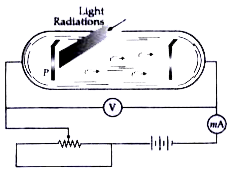Consider a beam of electrons (each electron with energy E0) incident on a metal surface kept in an evacuated chamber. Then
no electrons will be emitted as only photons can emit electrons.
electrons can be emitted but all with an energy E0
Electrons can be emitted with any energy, with a maximum of E0−ϕ (ϕ is the work function).
electron can be omitted with energy, with a maximum of E0.
The correct Answer is:D
If a beam of electrons of having energy E0 is incident on a metal surface kept in an evacuated chamber.

The electrons can be emitted with maximum energy E0 (due to elastic collision) and with any energy less than E0, when part of incidnet energy of electron is used in liberating the electrons from the surface of metal
Similar Questions
Two beams one of red light and other of blue light of the same intensity are incident on a metallic surface to emit photoelectrons. Which one of the two beam emits electrons of greater kinetic energy?
View SolutionIf we go on increasing the wavelength of light incident on a metal surface, what change in the number of electrons and the energy take place?
View Solution
Knowledge Check
The electrons are emitted in the photoelectric effect from a metal surface
Aonly if the frequency of the incident radiation is above a certain threshold valueBonly if the temperature of the surface is highCat the rate of independent of the nature of the metalDnone of theseThe electrons are emitted in a photoelectric effect from a metal surface
Aonly if the frequency of radiation is above a certain threshold valueBonly if the temperature of surface is lowCat a rate that is independent of the nature of metalDwith a maximum velocity proportional to the frequency of incident radiation .When light of energy 2.5 eV falls on a metal surface, the maximum K.E. of the emitted electrons is T. If the radiation of energy 4eV is made incident on the same metal surface, the K.E. of the electrons is doubled. What is the work function of the metal ?
A0.5 eVB1 eVC1.5 eVD2 eV
Work function of Sodium is 2.75 eV. What will be K.E. of emitted electron when photon of energy 3.54 eV is incident on the surface of sodium ?
View SolutionStatement 1: Though light of a single frequency (monochromatic light) is incident on a metal, the kinetic energies of emitted photoelectrons are not equal. Statement 2: The energy of electrons just after they absorb photons incident on metal surface may be lost in collision with other atoms in the metal before the electron is ejected out of the metal.
View SolutionIn each of the following questions, a statement is given and a corresponding statement or reason is given just below it. In the statement, mark the correct answer as
Statement-I: Though light of a single frequency (monochromic light) is incident ona metal, the energies of emitted photoelectrons are different
Statement-II: The energy of electrons just after they absorb photons incident on the metal surface may be lost in collision with other atoms in the metal before the electron is ejected out of the metal.
View SolutionStatement-1: The photoelectrons produced by a monochromatic light beam incident on a metal surface have a spread in their kinetic energies.
Statement-2: The work function of the metal varies as a function of depth form the surface.
View SolutionIn a photoelectric effect experiment , photons of energy 5.0 eV are incident on metal surface . They liberate electrons which are just stopped by an electrode at a potential of 3.5 eV with respect to metal . The work function of the metal surface in eV is :
View Solution
